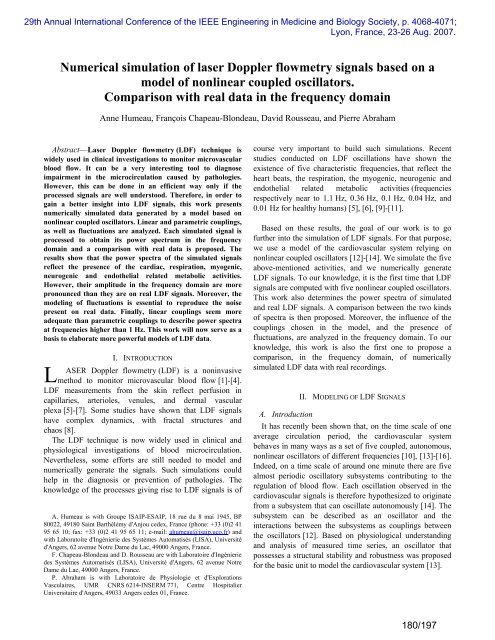a la physique de l'information - Lisa - Université d'Angers
a la physique de l'information - Lisa - Université d'Angers
a la physique de l'information - Lisa - Université d'Angers
You also want an ePaper? Increase the reach of your titles
YUMPU automatically turns print PDFs into web optimized ePapers that Google loves.
Numerical simu<strong>la</strong>tion of <strong>la</strong>ser Doppler flowmetry signals based on a<br />
mo<strong>de</strong>l of nonlinear coupled oscil<strong>la</strong>tors.<br />
Comparison with real data in the frequency domain<br />
Anne Humeau, François Chapeau-Blon<strong>de</strong>au, David Rousseau, and Pierre Abraham<br />
Abstract—Laser Doppler flowmetry (LDF) technique is<br />
wi<strong>de</strong>ly used in clinical investigations to monitor microvascu<strong>la</strong>r<br />
blood flow. It can be a very interesting tool to diagnose<br />
impairment in the microcircu<strong>la</strong>tion caused by pathologies.<br />
However, this can be done in an efficient way only if the<br />
processed signals are well un<strong>de</strong>rstood. Therefore, in or<strong>de</strong>r to<br />
gain a better insight into LDF signals, this work presents<br />
numerically simu<strong>la</strong>ted data generated by a mo<strong>de</strong>l based on<br />
nonlinear coupled oscil<strong>la</strong>tors. Linear and parametric couplings,<br />
as well as fluctuations are analyzed. Each simu<strong>la</strong>ted signal is<br />
processed to obtain its power spectrum in the frequency<br />
domain and a comparison with real data is proposed. The<br />
results show that the power spectra of the simu<strong>la</strong>ted signals<br />
reflect the presence of the cardiac, respiration, myogenic,<br />
neurogenic and endothelial re<strong>la</strong>ted metabolic activities.<br />
However, their amplitu<strong>de</strong> in the frequency domain are more<br />
pronounced than they are on real LDF signals. Moreover, the<br />
mo<strong>de</strong>ling of fluctuations is essential to reproduce the noise<br />
present on real data. Finally, linear couplings seem more<br />
a<strong>de</strong>quate than parametric couplings to <strong>de</strong>scribe power spectra<br />
at frequencies higher than 1 Hz. This work will now serve as a<br />
basis to e<strong>la</strong>borate more powerful mo<strong>de</strong>ls of LDF data.<br />
I. INTRODUCTION<br />
L<br />
ASER Doppler flowmetry (LDF) is a noninvasive<br />
method to monitor microvascu<strong>la</strong>r blood flow [1]-[4].<br />
LDF measurements from the skin reflect perfusion in<br />
capil<strong>la</strong>ries, arterioles, venules, and <strong>de</strong>rmal vascu<strong>la</strong>r<br />
plexa [5]-[7]. Some studies have shown that LDF signals<br />
have complex dynamics, with fractal structures and<br />
chaos [8].<br />
The LDF technique is now wi<strong>de</strong>ly used in clinical and<br />
physiological investigations of blood microcircu<strong>la</strong>tion.<br />
Nevertheless, some efforts are still nee<strong>de</strong>d to mo<strong>de</strong>l and<br />
numerically generate the signals. Such simu<strong>la</strong>tions could<br />
help in the diagnosis or prevention of pathologies. The<br />
knowledge of the processes giving rise to LDF signals is of<br />
A. Humeau is with Groupe ISAIP-ESAIP, 18 rue du 8 mai 1945, BP<br />
80022, 49180 Saint Barthélémy d'Anjou ce<strong>de</strong>x, France (phone: +33 (0)2 41<br />
95 65 10; fax: +33 (0)2 41 95 65 11; e-mail: ahumeau@isaip.uco.fr) and<br />
with Laboratoire d'Ingénierie <strong>de</strong>s Systèmes Automatisés (LISA), <strong>Université</strong><br />
<strong>d'Angers</strong>, 62 avenue Notre Dame du Lac, 49000 Angers, France.<br />
F. Chapeau-Blon<strong>de</strong>au and D. Rousseau are with Laboratoire d'Ingénierie<br />
<strong>de</strong>s Systèmes Automatisés (LISA), <strong>Université</strong> <strong>d'Angers</strong>, 62 avenue Notre<br />
Dame du Lac, 49000 Angers, France.<br />
P. Abraham is with Laboratoire <strong>de</strong> Physiologie et d'Explorations<br />
Vascu<strong>la</strong>ires, UMR CNRS 6214-INSERM 771, Centre Hospitalier<br />
Universitaire <strong>d'Angers</strong>, 49033 Angers ce<strong>de</strong>x 01, France.<br />
course very important to build such simu<strong>la</strong>tions. Recent<br />
studies conducted on LDF oscil<strong>la</strong>tions have shown the<br />
existence of five characteristic frequencies, that reflect the<br />
heart beats, the respiration, the myogenic, neurogenic and<br />
endothelial re<strong>la</strong>ted metabolic activities (frequencies<br />
respectively near to 1.1 Hz, 0.36 Hz, 0.1 Hz, 0.04 Hz, and<br />
0.01 Hz for healthy humans) [5], [6], [9]-[11].<br />
Based on these results, the goal of our work is to go<br />
further into the simu<strong>la</strong>tion of LDF signals. For that purpose,<br />
we use a mo<strong>de</strong>l of the cardiovascu<strong>la</strong>r system relying on<br />
nonlinear coupled oscil<strong>la</strong>tors [12]-[14]. We simu<strong>la</strong>te the five<br />
above-mentioned activities, and we numerically generate<br />
LDF signals. To our knowledge, it is the first time that LDF<br />
signals are computed with five nonlinear coupled oscil<strong>la</strong>tors.<br />
This work also <strong>de</strong>termines the power spectra of simu<strong>la</strong>ted<br />
and real LDF signals. A comparison between the two kinds<br />
of spectra is then proposed. Moreover, the influence of the<br />
couplings chosen in the mo<strong>de</strong>l, and the presence of<br />
fluctuations, are analyzed in the frequency domain. To our<br />
knowledge, this work is also the first one to propose a<br />
comparison, in the frequency domain, of numerically<br />
simu<strong>la</strong>ted LDF data with real recordings.<br />
A. Introduction<br />
II. MODELING OF LDF SIGNALS<br />
It has recently been shown that, on the time scale of one<br />
average circu<strong>la</strong>tion period, the cardiovascu<strong>la</strong>r system<br />
behaves in many ways as a set of five coupled, autonomous,<br />
nonlinear oscil<strong>la</strong>tors of different frequencies [10], [13]-[16].<br />
In<strong>de</strong>ed, on a time scale of around one minute there are five<br />
almost periodic oscil<strong>la</strong>tory subsystems contributing to the<br />
regu<strong>la</strong>tion of blood flow. Each oscil<strong>la</strong>tion observed in the<br />
cardiovascu<strong>la</strong>r signals is therefore hypothesized to originate<br />
from a subsystem that can oscil<strong>la</strong>te autonomously [14]. The<br />
subsystem can be <strong>de</strong>scribed as an oscil<strong>la</strong>tor and the<br />
interactions between the subsystems as couplings between<br />
the oscil<strong>la</strong>tors [12]. Based on physiological un<strong>de</strong>rstanding<br />
and analysis of measured time series, an oscil<strong>la</strong>tor that<br />
possesses a structural stability and robustness was proposed<br />
for the basic unit to mo<strong>de</strong>l the cardiovascu<strong>la</strong>r system [13].<br />
180/197


